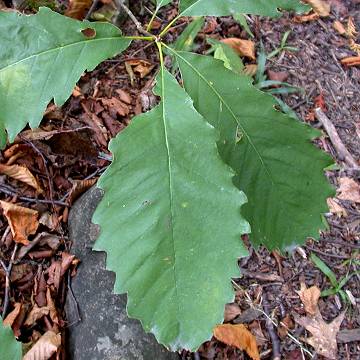

Quercus muhlenbergii - (image 1 of 7)
Taxonomy
Family: Fagaceae
Habitat
Wooded, often rocky, slopes or shaded slopes of old dunes. Usually on calcareous soil.
Associates
Distribution
VT west to southeast MN and western NE, south to northern FL, AL, and TX.
Morphology
Deciduous tree to 25 m. Bark gray, thin, flakey. Leaves alternate, green above, densely pubescent or tomentose below, to 20 cm, shallowly lobed, with 9-14 lateral pairs of veins running into the teeth, the teeth each often sharp and ending in a minute, callous papilla. Acorn sessile, the cup 1-2 cm wide, with many small scale that are free at the tip; nut ovoid.
Notes
Flowers mid May
Wetland indicator: Upland
Also called Yellow Chestnut Oak. Has yellow-brown fall color. Can hybridize with the more shrubby Q. prinoides Willd. (Dwarf Chinquapin Oak), which can grow to 3-5 m and has 5-8 pairs of lateral veins to each leaf.
Quercus montana (Chestnut Oak) is similar but has leaves with rounded teeth that are sparsely hairy beneath. The cap of the acorn is hemispheric and has comparatively few scales; nut dark brown. Found from ME south to northern GA in the Appalachians, west to southern IL and northern MS; disjunct in southern MI.
References
Farrar, J. L. 1995. Trees of the Northern United States and Canada.
Ames, Iowa: Iowa State University Press
Gleason, Henry A. and A. Cronquist. 1991. Manual of Vascular Plants of Northeastern United States and Adjacent Canada. Second Ed.
The New York Botanical Garden. Bronx, NY
Swink, F. and G. Wilhelm. 1994. Plants of the Chicago Region.
Indiana Academy of Science. The Morton Arboretum. Lisle, Illinois.
|
Michael Hough © 2005 |